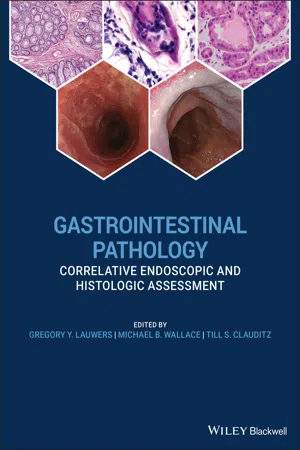
Gastrointestinal Pathology
Correlative Endoscopic and Histologic Assessment
- English
- ePUB (mobile friendly)
- Available on iOS & Android
Gastrointestinal Pathology
Correlative Endoscopic and Histologic Assessment
About this book
An illustrated guide to best practices when performing and assessing biopsies for GI conditions of all kinds
Accurate diagnosis of GI conditions necessarily entails both the careful taking of biopsies and the informed analysis of tissue material. With that being so, gastroenterologists and GI pathologists alike must have a solid understanding of the techniques, handling requirements, and diagnostic characteristics involved if they are to collaborate effectively. Gastrointestinal Pathology has been designed to provide a clinically focussed and richly illustrated guide to real-world scenarios faced by practicing GI specialists, offering step-by-step instruction and professional advice on the correct diagnosis of all major GI conditions. This essential new book includes:
- Full-color illustrations throughout
- Complete details of biopsy samples required to diagnose specific conditions
- Reviews of differential diagnoses
- Clinical management clues based on pathologic findings
Featuring information to improve the practice of all gastroenterologists and GI pathologists, Gastrointestinal Pathology is a practical and every-day resource for the precise diagnosis of a wide range of GI conditions.
Frequently asked questions
- Essential is ideal for learners and professionals who enjoy exploring a wide range of subjects. Access the Essential Library with 800,000+ trusted titles and best-sellers across business, personal growth, and the humanities. Includes unlimited reading time and Standard Read Aloud voice.
- Complete: Perfect for advanced learners and researchers needing full, unrestricted access. Unlock 1.4M+ books across hundreds of subjects, including academic and specialized titles. The Complete Plan also includes advanced features like Premium Read Aloud and Research Assistant.
Please note we cannot support devices running on iOS 13 and Android 7 or earlier. Learn more about using the app.
Information
1
General Principles of Biopsy Diagnosis of GI Disorders
- Endoscopic equipment for obtaining tissue including endoscopic accessory channels, biopsy forceps, snare devices, needle aspiration and cytology brush.
- General principles of optimal sampling technique.
- Methods of tissue preparation in the endoscopy laboratory to optimize diagnostic accuracy.
- The role of endoscopic ultrasound (EUS)‐guided fine‐needle aspiration cytology.
Endoscopic Equipment for Tissue Sampling



Pinch Biopsy Forceps
Table of contents
- Cover
- Table of Contents
- Title Page
- Copyright Page
- List of Contributors
- 1 General Principles of Biopsy Diagnosis of GI Disorders
- 2Esophagus Inflammatory Conditions
- 3Epithelial Metaplastic, Polypoid, and Neoplastic Conditions of the Esophagus
- 4Inflammatory Disorders of the Stomach
- 5Polyps of the Stomach
- 6Gastric Neoplastic Conditions
- 7Inflammatory and Miscellaneous Conditions of the Small Intestine
- 8Polyps of the Small Intestine
- 9Epithelial and Nonepithelial Neoplasms of the Small Intestine
- 10Inflammatory Conditions of the Colon
- 11Polyps of the Large Intestine
- 12Epithelial Neoplasms of the Large Bowel
- 13Inflammatory Conditions of the Anus
- 14Polyps and Neoplastic Lesions of the Anus
- Index
- End User License Agreement